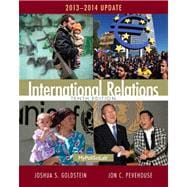The most current and comprehensive introduction to international relations theory
Thoroughly updated to cover world affairs through 2013, International Relations is praised for being the most current and comprehensive introduction to international relations theory, as well as security, economic, and global issues.
MyPoliSciLab is an integral part of the Goldstein program. Key learning applications include MyPoliSciLab Video Series, Explorer and Simulations.
A better teaching and learning experience
This program will provide a better teaching and learning experience–for you and your students. Here’s how:
- Personalize Learning– MyPoliSciLab is an online homework, tutorial, and assessment program. It helps students prepare for class and instructor gauge individual and class performance.
- Explore Concepts and Current Events–Includes a balanced survey of security, economic, and transnational issues.
- Improve Critical Thinking–Feature boxes help students apply international relations theory to current world problems.
- Engage Students–A four-color design and numerous figures, maps, and photos offer a current and lively reading experience.
- Emphasize Learning Outcomes–In MyPoliSciLab, study plans based on book-specific learning objectives give students follow-up reading, video, and multimedia activities for further practice.
- Support Instructors–A full set of supplements, including MyPoliSciLab, provides instructors with all the resources and support they need.
0205972152 / 9780205972159 International Relations: 2013-2014 Update Plus New MyPoliSciLab with eText -- Access Card Package, 10/e
Package consists of:
0205949975 / 9780205949977 NEW MyPoliSciLab with Pearson eText -- Valuepack Access Card
0205971369 / 9780205971367 International Relations, 2013-2014 Update
NOTE: MyPoliSciLab does not come automatically packaged with this text.








